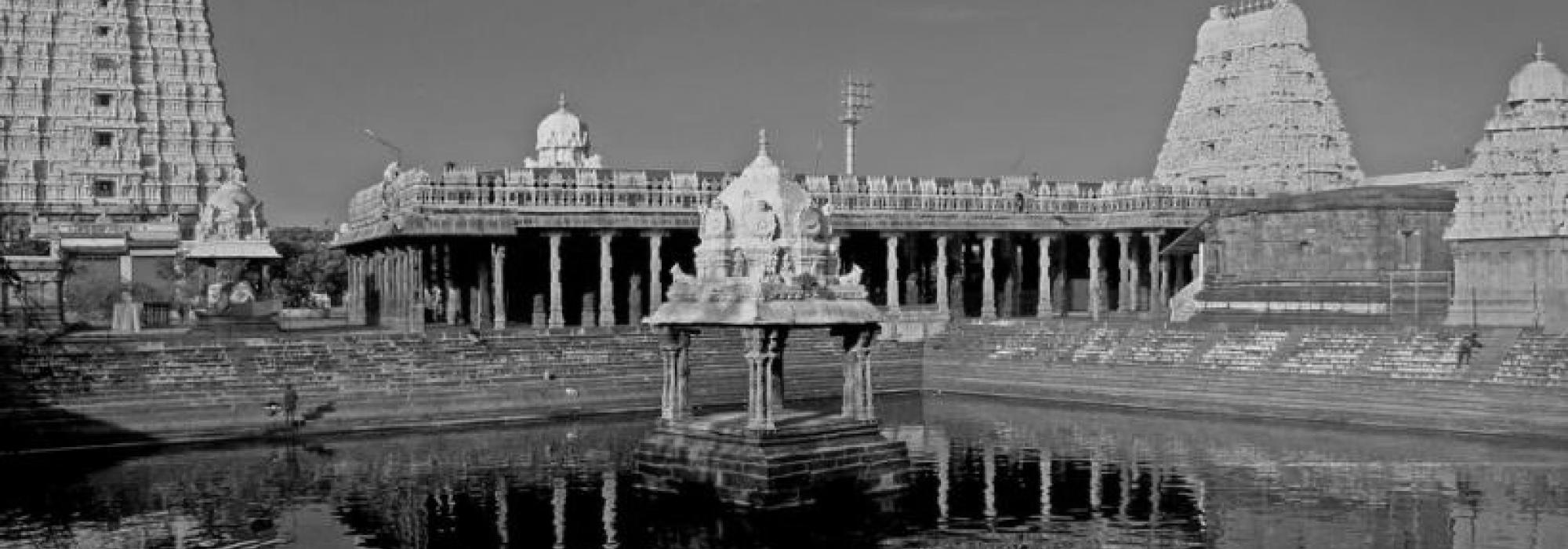1.Śiva’s form as Naṭarāja
We know from the first chapter of the Nāṭyaśāstra (verses 41-45) that according to tradition, Śiva’s cosmic dance inspired Bharata to add the kaiṣikī-vṛtti to classical dance and to include aṅgahāra. (An aṅgahāra is series of karaṇa-s and cāri-s, and are like sentences in a prose text; cāri-s are movements of the body below the waist). Śiva is portrayed in his form as a cosmic dancer and as ‘Naṭarāja’ (‘the king of dancers’) in the Nāṭyaśāstra (ca. 5000 BCE) and works of classical Sanskrit literature such as the Mālavikāgnimitram of Kāḻidāsa (verse 1.5, ca. 300-600 ACE) and the Mudrārākṣasa of Viśākadatta (verse 1.2, ca. 800 ACE). The sculpture of Mahānaṭa at Badami, Karnataka belongs to the 5th Century CE and depicts a dancing Śiva with eighteen arms, each in a different position. In the last decade, Dr. Karuna Vijayendra along with Sundari Santhanam, a student of Dr. Padma Subrahmanyam, upon close study of the Mahānaṭa sculpture, for the first time identified nine karaṇa-s derived from different combinations of the arms (Santhanam, 2013:19-20). Thus, we see from both literary and sculptural evidences that the concept of Śiva’s cosmic dance is an ancient one and was prevalent all over India. Calambur Sivaramamurti in his seminal work ‘Nataraja in Art, Thought and Literature’ gives evidence for the Vedic origin of the concept of Śiva as a cosmic dancer (Sivaramamurti, 1974).
The image of ‘Naṭarāja’ as seen in the popular tradition of ‘Ānanda Tāṇḍava’ and in Chidambaram is of later times. However, Padma Subrahmanyam showed that the ‘Naṭarāja-pose’ that is popularly seen is nothing but the twenty-fourth karaṇa, the bhujaṅgatrāsitam frozen during movement. This karaṇa is described by Bharata in the fourth chapter of the Nāṭyaśāstra (verses 84-85). Such sculptures of the dancer performing bhujaṅgatrāsitam are not merely found in Chidambaram but also in Kumbakonam and Tanjavur, but with the karaṇa frozen at different instances, giving them different postures. A different instant of the karaṇa is captured in the panels of the Prambanan too. (Subrahmanyam Volume – 3, 2003: 26-27; Subrahmanyam, Balakrishnan – segment 5). It is interesting to note that ‘Ānanda Tāṇḍava’ form is referred to only as Bhujaṅgatrāsitam in Rauravāgama, Sakalādhikāra, Ajitāgama and Karaṇāgama (Subrahmanyam Volume-2, 2003:91-93). Thus, Padma Subrahmanyam showed that though popular image of ‘Naṭarāja’ was seen in south India, its posture has origins in the Nāṭyaśāstra and similar postures and their variants are seen throughout India and South East Asia.
2.National integration and cultural unity expressed through solo and group presentations
As mentioned in the earlier sections, Padma Subrahmanyam did not limit herself to the reconstruction of the karaṇa-s and being a dance grammarian, but creatively applied them in various solo and group productions. Through her productions she has constantly established that Indian culture is one in its spirit but manifests differently in different regions of the country. All her productions adhere to Bharata’s tradition in their form, i.e.,mārga¸ and have diverse content. She, thus, showed that the rich grammar provided by Bharata can help enhance any content – be it classical or folk. Thus, the difference between classical and folk is only nominal and they are the same in spirit and they cater to Rasa, i.e., the aesthetic experience that entertains.
Through her thematic solo production ‘Valluvarum Vedaneriyum’, she showed that everything that was thought to be exclusive to the teachings of Thiruvalluvar of Tamil Nadu was found in the Vedas and ‘Thiruvalluvar-veda’ was a derivative of the four Vedas in its essence. She extensively research on the Tamil epic poem Cilappatikāram (Silappadikaram) and showed that every aspect of art that is mentioned in the epic has its roots in the Nāṭyaśāstra. She also choreographed a few episodes of the Cilappatikāram centered on the protagonist Kannagi and showed that the epic that was thought exclusive to Tamil Nadu and its culture can easily be adapted to the mārga-nāṭya tradition of Bharata and can be made accessible to people worldwide.
Similarly, by drawing themes from the works of many Tamil poets, she choreographed ‘Paripadal Mudhal Bharati Varai’ (Subrahmanyam, 2008), where she showed that all those themes were inseparable aspects of the pan-Indian culture and not exclusive to Tamil Nadu. She also presented Kamban’s Rāmāyaṇa as a theatrical production and pointed out to the Tamil chauvinists that Vālmīki’s Rāmāyaṇa had inspired the Tamil tradition too and Kamban’s was a beautiful adaptation of the same.
A great majority of Padma Subrahmanyam’s solo and theatrical productions are multi-lingual. These challenge the Tamil’s monolithic linguistic chauvinism. For instance, for the depiction of the same story line, she stitched together the compositions of Muttuswami Dikshitar and Rabindranath Tagore, the former an eighteenth century music composer of Tamil Nadu and the latter, a late nineteenth century poet of Bengal. In yet another production, she has shown that the madhura-bhakti as expressed by Lalleśvarī, a Kashmiri mystic poet of the fourteenth century, Meera Bai, a sixteenth century mystic saint of Rajasthan, Āṇḍāḻ, the seventh century Srivaishnavite saint and Akka-mahādevī, a saint poetess belonging to Karnataka’s Veerashaiva tradition is all the same. Through her production based on the compositions of Avvaiyar, she showed that the composer’s dhārmic tenets are derived from Manu’s sāmānya-dharma. Her production ‘Gurave-namaḥ’, an offering to the Paramācārya of Kanchi came as an answer to people who looked at maṭha-s with contempt. She upheld the spiritual tradition of the maṭha-s and stressed on their importance in socio-cultural integrity.
From her production Jaya Jaya Śaṅkara (Subrahmanyam, 2008), one can infer without any misgivings that the ṣaṇmata (the six ritualistic schools, including the one devoted to Kumāra, i.e., Subrahmaṇya popularly called Muruga in the Tamil tradition) is the basis for all ritualistic worship throughout India. By adapting Viralimalai Kurvanji, a concept that is thought to be exclusive to Tamil Nadu’s folk culture, to Bharata’s medium of nāṭya, she showed that all regional traditions find their root in Bharata and are inseparable parts of the pan-Indian culture. The story of Mīnākṣī-kalyāṇām (Subrahmanyam, 2008) choreographed as a group production, similarly shows its pan-Indian nature.
Padma Subrahmanyam’s solo adaptation of the Bhagavadgītā (Subrahmanyam, 2008) that uses Sanskrit verses from the original text, is interspersed with several aspects of folk rituals and traditions. It not only shows that all these folk traditions are equally valid methods in the spiritual pursuit, but is also a creative commentary on Sureśvarācārya’s view:
yayā yayā bhavet puṃsāṃ vyutpattiḥ pratyagātmani।
sā saiva prakriyā sādhvī viparītā tato'nyathā ॥
(Bṛhadāraṇyaka-bhāṣya-vārtika 1.4.402)
i.e., all paths that lead one to the realization of ātman, that is Ānanda (eternal Bliss) in its essence, are valid.
This spiritual integrity and vedāntic undercurrent common to all Indian arts, rituals, traditions and customs are emphasized throughout the production on Bhagavadgītā. Her multi-lingual solo choreographies - Rāmāya tubhyam namaḥ (Subrahmanyam, 2008) and Kṛṣṇāya tubhyam namaḥ (Subrahmanyam, 2008) show the cultural oneness of the country. We get to know from these choreographies that though the stories of Rāma and Kṛṣṇa have different creative interpolations in different regions of India, they are same in spirit.
Padma Subrahmanyam has also choreographed compositions of Subrahmanya Bharati, a nationalist. In the piece Velli Panimalayin (Subrahmanyam, 2014), she depicts the ideal of national integrity and cultural exchange between different regions of India. A boat ride on the river Sindhu on a full moon light with women from Kerala, gifting betel leaves grown in Tamil Nadu to the people of Punjab and receiving wheat in return, exchange of Karnataka’s gold for the stories of valour from Maharastra, etc are ideals for national harmony. She even did a multilingual production called ‘Vande Mātaram’ to highlight this concept. The universality of Bharata’s tradition is further proved by her adaptation of Tchaikovsky’s music to depict the episode of Jaṭāyu-mokṣa through classical Bharata-nṛtyam.
To be continued .....
Bibliography
- Subrahmanyam, Padma and Balakrishnan, V. Bharatiya Natyashastra – 14 segment serial, Doordashan
- George, TJS (2004) MS-A Life in Music¸ HarperCollins Publishers, India
- Hindusim Today. ‘Symposium Om Muruga!’ News, May 1999
- Malhotra, Rajiv and Neelakandan, Aravindan (2011). Breaking India – Western Interventions in Dravidian and Dalit Faultlines. Amaryllis. Delhi
- Nagar, RS (Ed.) (2012) Nāṭyaśāstra of Bharatamuni. Parimal Publications, Delhi
- Raghavan V (2004). Splendours of Indian Dance. Dr. V Raghavan Centre For Performing Arts, Chennai
- Subrahmanyam, Padma (2003). Karaṇas – Common Dance Codes of India and Indonesia. Nrithyodaya, Chennai
- Subrahmanyam, Padma (2008). Nritya Saptaham. Nrityodaya, Swathi Soft Solutions and Kalakendra, Chennai [A set of seven DVDs]
- Subrahmanyam, Padma (2014) Vellai Pani Malai https://www.youtube.com/watch?v=6V4L7D3Xg4I, (accessed 28 August 2017)
- Subrahmanyam, Padma http://www.padmadance.com/nrithyodaya/school.htm, (accessed 28 August 2017)
- Iyer, Alessandra.(1996) “Prambanan revisited: a fresh perspective on the dance sculptures of Candi Śiwa”, Bulletin de l'Ecole française d'Extrême-Orient Année. 1996 Volume 83 Numéro 1 pp. 157-184
- Iyer, Alessandra (2000). “Śiva's Dance: Iconography and Dance Practice in South and Southeast Asia”, Music in Art. Vol. 25, No. 1/2, pp. 25-32
- Santhanam, Sundari (2013). Neo deśi karaṇas – a sequential link. Bharata Nrityasala, Bangalore
- Sivaramamurti, C(1974). Nataraja in Art, Thought and Literature, National Museum: distributors, Publications Division [Ministry of Information and Broadcasting, Government of India],










































